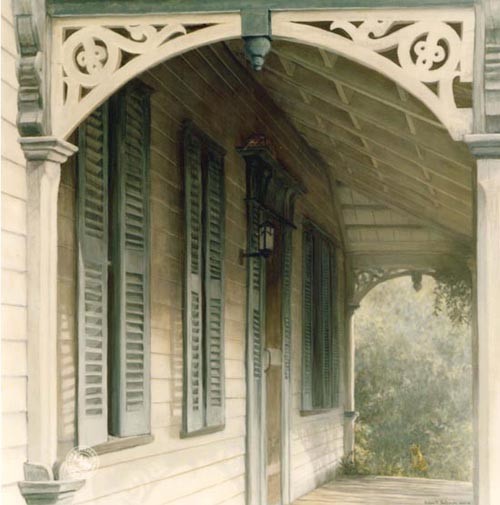Description
Lucas Porch by Robert Bateman
(24-1/2 x 24-1/2; Offset Paper; Edition Size 1250; $195.00 U.S.) (31 x 31; Giclee Canvas; Edition Size 180; $750.00 U.S.)
“Lucas Farm was established in the 19th Century on good land near the school where I was teaching in the 1970s. By the time I discovered it, its fate was sealed. Urban sprawl had made farming an untenable land use. The Lucas family kindly allowed me to take my art students onto the property on sketching trips. Although its old charm remained, the Victorian house was being taken over by a tangle of nature. To me the cracks and peeling paint added the dignity of age to the sprightly and lyrical architectural details. These details speak to me of an exuberant and inventive period in our history.
A family of robins is in residence above the no-longer-used front door. Lucas Farm also forms part of the territory of a house cat. This efficient hunter will be very interested in the baby robins if they should flutter within reach. Even well fed house cats kill millions of birds each year. They are programmed predators. The message in this painting is please control your cat. It certainly would be better for the birds.
.
BACKGROUND
The mid 1800’s represented a turning point in Canadian agriculture. Ontario farmers were able to sell their wheat crops for record-high prices. The American civil war created a demand for food of all kinds, and the wheat farmers were able to diversify into fruits, vegetables, hogs and cattle. The Douglass-Lucas farmhouse is a demonstration of Ontario’s newfound prosperity.
Located on a 100-acre parcel in Halton County, near Burlington, the house was built by Thomas Douglass. Typical of the era, the house was built in the Georgian Style-symmetrical and having a center hall plan. Sold to John Lucas in 1856, the house was occupied by generations of Lucas family farmers for 117 years. It was then purchased in 1973 by Stelco Steel Canada who donated it to the Country Heritage Park Museum in Milton.”
Robert Bateman
Biography
Robert Bateman has been called the most famous living artist. He continues to paint and tour the world to promote conservation and preservation of nature. We have represented Robert Bateman for decades and are now the sole publisher and distributor of his reproductions. We are so honored to work with him and witness his success. He has made such a massive contribution to the art world and the natural world as an artist and educator of the earth’s most important resources.
Nature as a subject is becoming more and more popular as our environment is in peril. What better subject is there than the beautiful creatures we share this world with? Robert Bateman’s appreciation and understanding of nature are apparent in his paintings. He is able to paint flora and fauna the way your eye would perceive it in real life. It is important that the animal takes full attention. The background becomes muted, and therefore it doesn’t take too much focus away from the subject. His paintings seem effortless and masterful all at once.
Bateman’s eye for composition is unparalleled. Each painting is a composed like a symphony, leading the eye to wander. From the backyards of North America to the sprawling plains of Africa. Robert Bateman captures nature the way it should be enjoyed. Above all he is a champion of wildlife. For this reason he has become a household name for art collectors.


